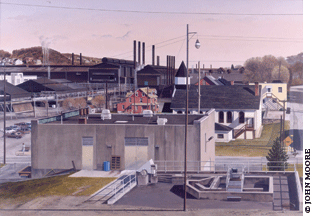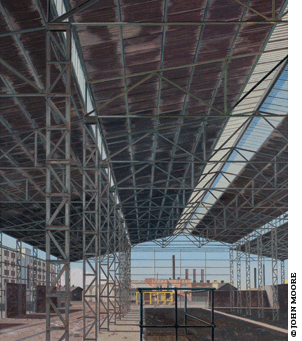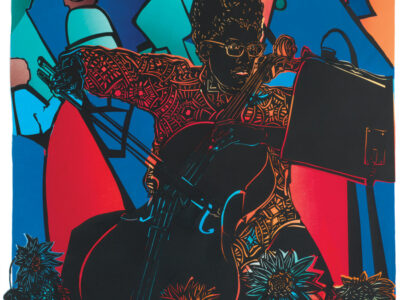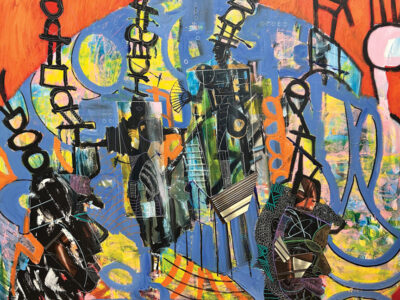
John Moore first set foot in the aging industrial town of Coatesville, Pennsylvania in 1986. In a sense, it was like going home. For one thing, he was familiar with the depictions of the town and its sprawling Lukens Steel plant by Ralston Crawford and Charles Demuth half a century before. For another, he had grown up in something of an industrial landscape himself in the Wellston suburb of St. Louis.
“When I first went to Coatesville, with reproductions in my hand of painters who’d been there before, I felt immediately like, ‘I know this place; I’ve been here before,’” recalls Moore, the Gutman Professor of Fine Arts, who is stepping down as chair of the fine-arts department at the end of June. “It was so much like the area I grew up in.”

After painting his massive Coatesville (1986-89), he left the Philadelphia area for a decade; since his return in 1999 he has visited and painted the town numerous times. His recent series of four “monumental” Coatesville landscapes is a “tour de force, as well as a reflection of his extraordinary talent,” says Lynn Marsden-Atlass, director of the Arthur Ross Gallery, which is presenting a focused exhibition of Moore’s industrial landscapes spanning more than two decades. “Thirteen Miles from Paradise,” held in conjunction with the School of Design, opens April 11 and runs through June 14.
The title refers to the fact that Coatesville is just 13 miles east of Paradise, a tiny Amish village in rural Lancaster County. But the psychic distance between them might as well be measured in light-years.
In revisiting the steel mills Crawford and Demuth had documented 50 years before, Moore was “tacitly affirming a continuity with the Precisionists, a relatively little-known group of American painters,” notes Alexi Worth in an essay for the exhibition’s catalogue. And with these paintings, “Moore seems to offer both homage and subtle reproof to the Precisionists, matching their mechanical finesse, while amplifying and correcting their formalism with a wider sense of human subject matter. If the Precisionists were painter-engineers, Moore is simultaneously engineer, art historian, and sociologist.”

A few years ago Moore told the Gazette that he was drawn to urban and industrial landscapes because of their “visible evidence of change: the way that things have been altered by time or circumstances or economics.” [“All Things Ornamental,” March|April 2006.] While Coatesville and Lukens Steel have changed a good deal since he began painting them, his visceral connection to the landscape has not.
“You know, you can go to places and you can be there a long time, and you always feel like you’re an outsider,” says Moore. “I lived in Boston for 12 years, and I never really felt like I connected with it. But Coatesville, on the other hand, I just felt right away, ‘I know this place; I know what it smells like; I know what it feels like; I know the texture of it.’ And I thought, ‘What a rich place to work.’”
—S.H.




